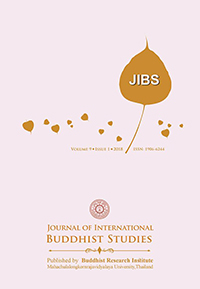Application of Teachings in the Sabbāsavasutta for Managing Stress
Keywords:
application, stress, management, removal, developmentAbstract
The purpose of this article is to study the ways to apply teachings in the Sabbāsavasutta to manage stress. First of all an introduction to the severity of the stress and significance of finding new ways to overcome stress is given. Then the way to apply the method of seeing has been analytically presented. The importance of obtaining a clear view is emphasized in this step. Afterwards the ways to apply the methods of restraining, using, endurance, avoidance, removal have been presented accordingly. Finally the ways to apply the method of development has been elaborated emphasizing the fact that the development of positive factors is essential as well as the control and elimination of the negative aspects.
References
Abhayawansa, Kapila. (2014). Buddhist contribution for a Healthy Society towards the Millennium Development Goals, A Buddhist Approach to Healthy Living. Vietnam: Vietnam Buddhist University.
Bodhi, Bhikkhu. (2012). The Numerical Discourses of the Buddha. Boston: Wisdom Publications.
Bodhi, Bhikkhu. (2000). The Connected Discourses of the Buddha Vol. ii. Boston: Wisdom Publications.
Buddharakkhitha, Acharya. (2011). Mind Ovecoming its Cankers. Bangalore: Buddhavacana Trust.
Bullen, L. A. (1982). A technique of living: Based on Buddhist psycholgical principles. Kandy: Buddhist Publication Society.
Chalmers, Robert. (ed.). (2004). Majjhimanikāya. Vol. II. Oxford: PTS.
Charles, D, et all. (1996). Stress and Emotions: Anxiety, Anger and Curiosity.Washington: Taylor and Frasnsis.
Dhammananda, K.Sri.(2004). You and Your Problems. Kuala Lampur : Buddhist Missionary Society.
Dhammananda, K Sri. (2006). Why Worry. Kuala Lampur: Buddhist Missionary Society.
Dhammika, Mirisse.(2013). Stress Reduction for Youth through Mindfulness and Loving Kindness. Dehiwala: Buddhist Cultural Center.
Fazekas,Gabor. (2017). Introduction to MBSR, contemporary and traditional mindfulness,and an overview of new trends of integrating science and contemplative practice in the world and in Hungary, Mindfulness: Traditions and compassionate applications. Thailand: Mahaculalongkornrajavidyalay University.
Fink, George. (2000). Encyclopedia of Stress. California: Academic Press.
Gombrich, Richard. (1988). Theravada Buddhism. New York: Routledge.
Gunaratana, Pititgala. (2012). Sabbasavasutta. Colombo: Quality Printers.
Hales, Dianne. (2018). Personal Stress Management. Boston: Cengage Learning
Hardy, E. (ed.). (1999). Aṅguttaranikāya. Vol. IV. Oxford: PTS.
Herman, M. et all. (2004). Stress the Brain and Depression. Cambridge: Cambridge University Press.
Humphrey,James H.(2002). An Anthology of Stress. New York : Nova Science Publishers.
Hussain, Dilwar and Bhushan, Braj. (2010). Psychology of Meditation and Health: Present Status and Future Directions. International Journal of Psychology and Psychological Therapy. Almeria: University of Almeria.
Kariyawasam, Tilak. (2014). Moderate Consumption of food, A Buddhist Approach to Healthy Living. Vietnam: Vietnam Buddhist University.
Khalid, A., & Qadeer, F. (2018). Rising consumer materialism: A threat to sustainable happiness. New York: Routledge.
Koster, Frits. (2007). Buddhist Meditation in Stress Management. Chiangmai: Silkworm Books.
Mace, C. (March 01, 2007). Mindfulness in psychotherapy: an introduction. Advances in Psychiatric Treatment, 13(2), 147-154.
Mahathera, Narada. (1987). A Manual of Abhidhamma. Kuala Lumpur: Buddhist Missionary Society.
Mcintosh, Diane. et all. (2017). Stress: The Psychology of Managing Pressure. New York: D.K.Publishing.
Miller, Allen R. (2010). Living with Sress. New York: Facts On File.
Ñānamoli, Bhikkhu. and Bodhi, Bhikkhu. (2005). The Middle Length Discourses of the Buddha. Kandy: Buddhist Publication Society.
Ñānamoli, Bhikkhu. (2010). The Path of Purification. Kandy: Buddhist Publication Society.
Nyanatiloka. (1988). Buddist Dictionary. Kandy: Buddhist Publication Society.
Pemasiri, P.D. (2017). Theory and Practice of Mindfulness from the Theravada Textual Viewpoint, Mindfulness: Traditions and Compassionate Applications. Thailand: Mahaculalongkornrajavidyalay University.
Pategama Gnanarama. (2000). The Essentials of Buddhism. Singapore: Buddhist and Pali College.
Rathnasiri, R.M.(2014). An Explication of Healthy Living in Buddhist Perspective, A Buddhist Approach to Healthy Living. Vietnam: Vietnam Buddhist University.
Rose, J. (1994). Human stress and the environment: Health aspects. Yverdon: Gordon & Breach Science Publishers.
Rowe, Dorothy . (2003). Depression The Way Out of Your Prison. London: Routledge.
Seaward, Brian Luke. (2015). Managing Stress. Massachusetts: Jones & Bartlett Learning.
Silva, Padmasiri. (2014). An Introduction to Buddhist Psychology and Counseling. UK: Macmillan.
Slade, M., Oades, L. G., & Jarden, A. (2017). Wellbeing, recovery and mental health. Cambridge: Cambridge University Press.
Tithavanno. (2005). Mind Development. Nakhonpatom: Mahamakut University.
Tyson, P. D., & Pongruengphant, R. (August 21, 2007). Buddhist and Western perspectives on suffering, stress, and coping. Journal of Religion and Health, 46(3), 351-357.







